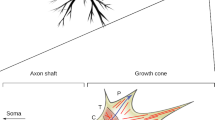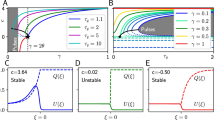Abstract
Simple chemical reactions of Ca++ and K+ ions with a P− ion in a membrane are assumed to be causes of changes in permeability of that membrane to K+ ions. On the basis of such a mechanism a quantative concept of membrane permeability to K+ ions is defined. The diffusion of K+ ions through such a membrane is studied mathematically in a simplified version. An applied electrical field as well as the diffusion potential of the K+ ions are considered to effect the chemical equilibrium constants of the proposed reactions. It is shown that such a system, which can be described by a set of nonlinear differential equations, may have two stable states of equilibrium which are separated by an unstable equilibrium state. As a consequence, such a system may possess a threshold. Estimations of resting potential, threshold—electrical as well as chemical—and of permeability increase, together with that of the corresponding electrical field strength are shown to have the correct order of magnitude. A possible way to derive the one-factor theory from a physical mechanism as considered here is outlined. It is pointed out that the dependence of the thresholds and the permeability changes on several parameters might be calculated on the basis of such a mechanism. As an example it is shown how in principle some of these relations are derived. Furthermore, the time course of excitatory disturbance for different intensities of the initial disturbance are derived theoretically for the case of chemical stimulation. The curves so obtained show a striking similarity in all the characteristic features with the corresponding ones which are obtained experimentally for the case of electrical stimulation of nerve. These results suggest that response to electrical and chemical stimulation is based on a common threshold phenomenon such as considered here. Finally, a more detailed mathematical description, which takes into account explicitly the diffusion of K+ ions through the membrane for a finite thickness of the membrane is outlined. The equations obtained, which seem to be infeasible of solution at the present time, suggest that it is plausible that relaxation oscillations with a threshold can be derived on the basis of such a mechanism as proposed here. Qualitative agreement with experimental evidence is indicated.
Similar content being viewed by others
Literature
Andronow, A. A. and C. E. Chaikin. 1949.Theory of Oscillations. (English Language Ed. by S. Lefshetz.) Princeton: Princeton University Press. (Russian Ed., 1937.)
Arvanitaki, A. 1938a.Propriétés Rhythmiques de la Matière Vivante. I. Étude Expérimentale sur les nerfs isolés d'invertébrés. Paris: Hermann & Cie.
— 1938b.Propriétés Rhythmique de la Matière Vivante. II. Étude Expérimentale sur le Myocarde d'Helise. Paris: Hermann & Cie.
— 1939. “Recherches sur la Réponse Oscillatoire Locale de l'Axone Géant Isolé de ‘Sepia’.”Archiv. Intern. de Physiol. 49, 209–56.
Auger, D. 1936.Comparaison entre la Rythmicité des Courants d'Action Cellulaires chez les Végétaux & chez les Animaux. Paris: Hermann & Cie, Ed.
Bear, R. S. and F. O. Schmitt. 1939. “Electrolytes in the Axoplasm of the Giant Nerve Fibers of the Squid.”Jour. Cell. Comp. Physiol.,14, 205–15.
Bernstein, J. 1902. “Untersuchungen zur Thermodynamik der bioelektrischen Ströme.”Pflüg. Arch. f.d. ges. Physiol.,92, 521–62.
Bethe, A. 1937. “Rhythmik und Periodik besonders im Hinblick auf die Bewegungen des Herzens und der Meduse.”Pflüg. Arch.,239, 41–73.
— 1943. “Die periodische Unterbrechung rhythmischer Vörgange im Vergleich zu ähnlichen Vorgängen an elektrischen Kipp systemen.” —Ibid.,,246, 485–519.
— and H. Schaefer. 1947. “Erregungsgesetze einer Blinkschaltung im Vergleich zu denen biologischen Objekte.”Pflüg. Arch.,249, 313–38.
Bonhoeffer, K. F. 1948a. “Activation of Passive Iron as a Model for the Excitation of Nerve.”Jour. Gen. Physiol.,32, 69–91.
— 1948b. “Über periodische chemische Reaktionen I.”Zeitschr. f. Elektroch. und angew. physik Chem.,51, 24–9.
— et al. 1948c. “Über periodische chemische Reaktionen II.”Zeitschr. f. Elektroch. und angew physik. Chem.,51, 29–37
— et al. 1948d. “Über periodische Reaktionen III.” —Ibid.,,52, 60–7.
— et al. 1948e. “Über periodische Reaktionen IV.” —Ibid.,,52, 67–72.
— et al. 1948f. “Über periodische Reaktionen V.” —Ibid.,52, 149–160.
Brink, F. and others. 1946. “Chemical Excitation of Nerve.”Ann. N. Y. Acad. Sci.,47, 457–485.
Cole, K. S. and H. J. Curtis. 1938. “Impedance of Nitella during Activity.”Jour. Gen. Physiol.,22, 37–64.
— 1939. “Impedance of the Squid Axon during Activity.” —Ibid.,,22, 649–670.
— 1940. “Membrane Potential of the Squid Giant Axon during Current Flow.” —Ibid.,24, 551–563.
Danielli, J. F. and H. Davson. 1935. “A Contribution to the Theory of Thin Films.”Jour. Cell. and Comp. Physiol.,5, 495–508.
Davson, H. and J. F. Danielli. 1943.The Permeability of Natural Membranes. Cambridge: University Press.
Eichler, W. 1933. “Schwelle, Akkommodation und elektrotonische Erregbarkeitsänderung des Nerven als Phänomene der Erregungsleitung.”Zeitchr. f. Biol.,93, 407–458.
Engström, A. and H. Lütky. 1950. “Distribution of mass and lipids in the nerve fiber.”Exp. Cell. Res.,1(1), 81–91.
Eriksson, E. 1949. “Ionic Diffusion through Membranes.”Ann. Roy. Agric. Coll. Sweden,16, 420–440.
Fessard, A. 1931. “Les Rythmes Nerveuse et les Oscillations de Relaxation.”L'Année Psychol.,32, 49–117.
— 1936a.Propriétés Rythmiques de la Matière Vivante I. Nerfs Isolés (1).Nerfs Myélinisés. Paris: Hermann & Cie.
— 1936b.Propriétés Rythmiques de la Matière Vivante II. Nerfs Isolés (2). Nerfs non Myélinisés. Paris: Hermann & Cie.
Fleckenstein, A. 1942. “Beitrag zum Mechanismus der Muskelkontraktion und zur Entstehung der Aktionströme.”Pflüg. Arch. f.d. ges. Physiol.,246, 411–27.
Friedrichs, K. O. 1946.On Nonlinear Vibrations of Third Order. New York: New York Univ. Inst. for Math. and Mech.
Fulton, J. F. 1947.Howell's Textbook of Physiology. Philadelphia and London: Saunders Co.
Heilbrunn, L. V. 1943.An Outline of General Physiology. Philadelphia and London: Saunders Co.
Hill, S. E. and W. J. V. Osterhout. 1934. “Nature of the Action Current in Nitella. II.”Jour. Gen. Physiol.,18, 377–83.
— 1937. “Calculations of Bioelectric Potentials II.” —Ibid.,,21, 541–56.
— 1938. “Nature of the Action Current in Nitella IV.” —Ibid.,,22, 91–100.
Höber, R. 1945.Physical Chemistry of Cells and Tissues. Philadelphia and Toronto: The Blakiston Co.
Hodgkin, A. L. 1947. “The Effect of Potassium on the Surface Membrane of an Isolated Axon.”Jour. Physiol.,106, 319–40.
— 1949. “Ionic Exchange and Electrical Activity in Nerve and Muscle.”Arch. des. Sci. Physiol.,III, 151–64.
— and A. F. Huxley. 1947. “Potassium Leakage from an Active Nervefiber.”Jour. Physiol.,106, 341–66.
—, A. F. Huxley and B. Katz. 1949. “Ionic Currents Underlying Activity in the Giant Axon of the Squid.”Arch. des Sci. Physiol.,III, 129–50.
Jordan, P. 1944. “Quantenphysik und Biologie.”Naturwissenschaften,32, 309–16.
Karreman, G. 1949. “Some Types of Relaxation Oscillations as Models of Allor-none Phenomena.”Bull. Math. Biophysics,11, 311–18.
Katz, B. 1937. “Experimental Evidence for a non-conducted Response of Nerve to Subthreshold Stimulation.”Proc. Roy. Soc. B.,124, 244–76.
— 1939.Electric Excitation in Nerve. London: Oxford University Press.
— 1947. “Subthreshold Potentials in Medullated Nerve.”Jour. Physiol.,106, 66–79.
Krylov, N. and N. Bogoliuboff. 1949.Introduction to Non-Linear Mechanics. (English Ed. by S. Lefschetz.) Princeton: Princeton University Press. (Ukran Eds., 1934 and 1937).
Lefshetz, S. 1950.Contributions to the Theory of Non-Linear Oscillations. Princeton: Princeton University Press.
Lillie, R. S. 1923.Protoplasmic Action and Nervous Action. Chicago: University of Chicago Press.
— 1924. “Factors Affecting Transmission and Recovery in the Passive Iron Nerve Model.”Jour. Gen. Physiol.,7, 473–507.
McLean, F. C. and A. B. Hastings. 1935. “The State of Calcium in the Fluids of the Body.”Jour. Biol. Chem.,108, 285–322.
Minorsky, N. 1947.Introduction to Non-Linear Mechanics. Ann Arbor: J. W. Edwards.
von Muralt, A. 1946.Die Signalübermittlung im Nerven. Basel: Verlag Birkhäuser.
Osterhout, W. J. V. 1933. “Anesthesia in Acid and Alkaline Solution.”Jour. Gen. Physiol.,17, 99–103.
— 1934. “Nature of the Action Current in Nitella I.” —Ibid.,,18, 215–27.
— 1949. “Some Bioelectrical Problems.”Proc. Nat. Acad. Sci.,35, 548–58.
— and S. E. Hill. 1934. “The Nature of the Action Current in Nitella III.”Jour. Gen. Physiol.,18, 499–514.
Poincaré, H. 1892.Les méthodes nouvelles de la mécanique céleste I. Paris: Gauthier-Villars.
van der Pol, B. 1926. “On Relaxation Oscillations.”Philosophical Mag.,2, November.
— and M. J. van der Mark. 1928. “Le battement du coeur considéré comme oscillation de relaxation et un modèle électrique du coeur.”L'Onde Electrique,7, 365–93.
Rapoport, A. 1950. “Contribution to the Probabilistic Theory of Neural Nets: II. Facilitation and Threshold Phenomena.”Bull. Math. Biophysics,12, 187–97.
Rashevsky, N. 1948.Mathematical Biophysics. Rev. Ed. Chicago: University of Chicago Press.
Rauch, L. L. 1950. “Oscillation of a Third Order Nonlinear Autonomous System.”Contributions to the Theory of Nonlinear Oscillations (Ed. S. Lefshetz). Princeton: Princeton University Press.
Rushton, W. A. H. 1932. “A New Observation in the Excitation of Muscle and Nerve.”Jour. Physiol.,75, 16P.
— 1937. “Initiation of the Propagated Disturbance.”Proc. Roy. Soc. B,124, 210–43.
Schaefer, H. 1940.Elektrophysiologie I. Wien: Frans Deuticke.
Schäfer, O. 1943. “Untersuchung an einer Schaltung zur Erzeugung ein-und aussetsender Kippschwingungen.”Pflüg. Arch. f.d. ges. Physiol.,246, 520–24.
von Schelling, H. 1944. “Das All-order-Nichts-Gesetz, gedentet als Endergebnis einer Auslösungsfolge.”Abh. d. Prensz. Akad. d. Wissensch, Nr. 6.
Stoker, J. J. 1950.Nonlinear Vibrations in Mechanical and Electrical Systems. New York and London: Interscience Publishers.
Tasaki, I. 1940. “Mikrophysiologische Untersuchung über die Grundlage der Erregungsleitung in der markhaltigen Nervenfaser.”Pflüg. Arch. f.d. ges. Physiol.,244, 125–41.
— and T. Takeuchi. 1941. “Der am Ranvierschen Knoten entstehende Aktionsstrom und seine Bedentung für die Erregungsleitung.”Pflüg. Arch. f.d. ges. Physiol.,244, 696–711.
Verwey, E. J. W. and J. Th. G. Overbeek. 1948.Theory of the Stability of Lyophobic Colloids. Amsterdam and New York: Elsevier.
Webb, D. A. and J. Z. Young. 1940. “Electrolyte content and action potential of the giant nerve fibres of Loligo.”Jour. Physiol.,98, 299–313.
Weinberg, A. M. 1942. “Non-linear Excitation Theory: Non-Accommodative, Sub-Threshold Effects.”Bull. Math. Biophysics,4, 33–44.
Author information
Authors and Affiliations
Rights and permissions
About this article
Cite this article
Karreman, G. Contributions to the mathematical biology of excitation with particular emphasis on changes in membrane permeability and on threshold phenomena. Bulletin of Mathematical Biophysics 13, 189–243 (1951). https://doi.org/10.1007/BF02478227
Issue Date:
DOI: https://doi.org/10.1007/BF02478227




